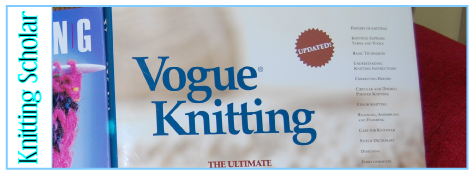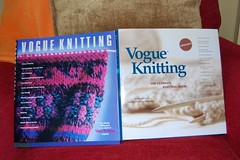First, the facts:
Title: Vogue Knitting
Author: The Editors of Vogue Knitting magazine
Published by: There are two editions: Pantheon Books, 1989; and Sixth & Spring Books, 2002
Pages: 280
Type: A comprehensive how-to book
Chapters:
1. History of Knitting
2. Knitting Supplies: Yarn and Tools
3. Basic Techniques
4. Understanding Knitting Instructions
5. Correcting Errors
6. Circular and Double-Pointed Knitting
7. Color Knitting
8. Blocking, Assembling and Finishing
9. Care of Knitwear
10. Stitch Dictionary
11. Designing
12. Embellishments
13. Modular Knitting Patterns
14. Traditional Knitting Patterns
15. Index
Pattern Size Range: Varies
The In-Depth Look:
As comprehensive knitting references go, it’s hard to beat this one. Vogue Knitting, in fact, is so nice, they produced it twice–the orignal version came out in 1989, and they revised and updated it in 2002.
I got my original copy as a Christmas gift in 1989. It was my first year out of college and, at $35, I couldn’t have afforded to buy it for myself. But I spent hours over the next few days reading through the entire book. I had only been knitting for a year or so and hadn’t yet tackled cables or lace, and barely knew what intarsia was, and this book was a door-opener.
I basically knitted my way through the book. While the rest of the family took post-turkey dinner naps, I sat with the book, a pair of knitting needles and some yarn, giving a try to each new concept as it came up. Cables? Hmm, let’s try that. Lace? Let’s see, yarn over, knit-two-together … I can do that. It was completely rewarding and enlightening at the same time. By the time I’d gotten through the book, I felt prepared to tackle just about anything.
So, what’s in this magical book, you ask? Well, what isn’t?
It starts with a history of knitting–pictures of ancient knitwear, the Prince of Wales in his iconic Fair Isle Vest. Just a few pages, but enough to give the reader a sense of how wide-spread knitting’s past is. Then, we get to the real meat.
The next chapter is about yarn and knitting tools–a vital topic, you’ll agree. It explains about the way yarn is constructed, how separate plies get spun together to make yarn, what kind of fibers can be used, the characteristics of different fibers. Instructions on reading the ball bands. Then, a section on the kinds of knitting needles–straight, circular, bamboo, aluminum, sizes, lengths and so on. This is followed by the accessories, like stitch markers, point protectors, swifts, graph paper … Basically, it’s an “all you need to know” look at what you physically need to actually KNIT.
Except, of course, the basic skills, which is what comes next. Of course, to start, you need to cast stitches onto your needle. Well! I counted 15 variations of cast-ons. Then, descriptions of knitting and purling for Continental, English, and left-handed knitters. How to join new yarn, variations on how to increase or decrease stitches, followed by 13 methods for binding-off. All accompanied by clear instructions and excellent illustrations. Anyone who reads Vogue Knitting magazine knows that their explanations of techniques is top-notch, and that is exactly what you get, here.
There’s a chapter on how to understand knitting patterns, and who doesn’t need help with that once in a while? I still come across abbreviations that I don’t recognize, and this list of spelled-out instructions is certainly handy. And the tips for fixing mistakes are certainly helpful. (I can’t tell you how many times I’ve used the “weave your needle into the row you want to frog to” tip when I’ve needed to rip back without risking dropping any stitches.)
Confused about the difference between Intarsia and Fair Isle? The chapter on color work will come in handy–a quick look at the different techniques, how to make yarn bobbins for color blocks, what Mosaic Knitting is.
The chapter on finishing techniques is wonderful–grafting, seaming, blocking, setting a sleeve, making a hem–it’s all in there, and there are useful instructions on how to care for your knits, too. How to wash them, how to store them–all that useful stuff.
There is also a good, basic stitch dictionary, giving a nice selection of various stitches. Not hundreds, perhaps, but dozens of different stitches you can play around with, each one with a full-color illustration, as well as both charts and line-by-line written instructions.
The section on design is excellent. Step-by-step instructions on what measurements you need, tips on how to calculate yardage for your yarn or for shaping the sleeves, schematics for different styles. Instructions on how to add different necklines, collars, pockets, and buttonholes. What kind of shaping you need to make a circular yoke-style sweater. There are more comprehensive design books out there, but considering this is just one section in an entire book, this is excellent. As are the “modular knitting patterns” that give you all the percentages and calculations you need to put together your own sweater.
Ultimately, this book comes across as THE reference–a book that covers (or at least touches) just about everything. It’s like the Joy of Cooking for knitting–accessible, with clear instructions, and with recipes for just about everything you need … though that doesn’t mean that it’s got every cake recipe you’re ever going to want. I’m not saying you’d never want another book, but if this was the only one you had, pretty much all of your knitting reference needs would be taken care of.
What’s not perfect? Well, the book gives a nice overview on “symbolcraft” to interpret charts. but of course, everybody knows that every designer and every publisher uses different symbols, so this isn’t necessarily as across-the-board useful as the rest of the book. And there may be some things that get skimmed over, like the more esoteric knitting and purling methods, while some techniques don’t make an appearance at all, like doing short rows without using wraps, or that 3D “illusion” knitting.
Or–the biggest omission–anything at all about knitting a sock, or how to shape a lace shawl. The focus, so far as patterns and design goes, is definitely on sweaters, which is its only real flaw to me. I love knitting sweaters, and VK is all about fashion knitting, but I don’t see why they couldn’t have added a page or two on basic sock structure, or tips on making a pair of mittens or a hat. A person is not kept warm by sweaters alone! But, still, with this book in your hand you should certainly be able to MAKE any sock or hat pattern you come across.
And what, you’re asking, is the difference between the two editions? Thanks to my good friend and close neighbor, Kim, who was willing to lend me her “updated” version to compare, I can tell you … not much! I didn’t read through both of them word for word, but I did page through them side by side and so far as I can tell, they’re more or less identical except for the cover and the handful of sweater patterns at the very back.
This surprised me a little. I hadn’t expected much to have changed in the basic instructions because, what, really, had changed in, say, knitting increases between editions? There are whole, large sections that I can’t imagine improving, but there is no mention of the “Magic Loop” or 2-circ methods of making socks in the section that talks about circular needles. They’re both techniques that came along well after the first edition was published, but apparently weren’t considered for the 2002 edition. And I didn’t really think the newer edition needed the section on shoulder pads that the 1989 version had, either. When’s the last time you knitted a shoulder pad?
So, I do think they lost an opportunity, there, for really updating their “Updated” edition, but since the material in the first edition was so good, I can live with it. It’s also true that, at this point, I’d be more likely to knit the sweaters at the back of the 2002 version than the 1989 version (grin).
Want a better look at the pictures? Click here.




Comments on this entry are closed.